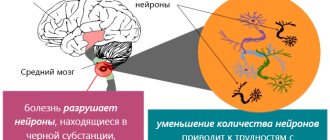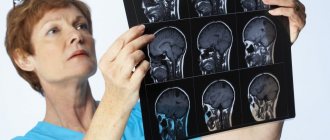ICD-10 is a universal coding method that includes information about all known disorders, pathologies, and diseases. Behind each of its codes lies the structure of diseases, their causes, and methods of treatment. Parkinson's disease code ICD 10 also includes. This pathology is one of the severe disorders of the nervous system that cannot be cured today.
Short description
Parkinson's disease (shaking palsy) is an idiopathic slowly progressive degenerative disease of the central nervous system, characterized by slowness of movements, muscle rigidity, tremors at rest and impaired postural reflexes. The disease is based on damage to pigmented dopaminergic neurons of the dense part of the substantia nigra and other dopamine-containing nuclei of the brain stem. The average age of onset of the disease is 57 years. The disease occurs less frequently in smokers, which is associated with the ability of tobacco smoke to inhibit MAO B. 5–24% of patients have a family history. Frequency. 1% of the population over 65 years of age; 0.4% of the population is over 40 years old.
Code according to the international classification of diseases ICD-10:
- G20 Parkinson's disease
Genetic classification
• Parkinson's disease with Lewy bodies (168601, Â) is characterized by early onset (on average at 47 years), rapid progression (death on average at 56 years), and absence of tremor. Pathomorphology: Lewy bodies in the cytoplasm of neurons.
• Juvenile parkinsonism (*600116, PDJ gene, 6q25.2–q27, r) is registered up to 40 years of age. Classic symptoms: bradykinesia, muscle rigidity, tremor. There is no dementia. Pathomorphology: neuronal degeneration and demyelination in the dense part of the substantia nigra and locus coeruleus; Lewy bodies are absent. Most cases have been recorded in people born from consanguineous marriages.
• Familial Parkinson's disease type 1 (#601508, PARK1 gene, 4q21–q23, 163890, Â) occurs due to mutations in the a - synuclein gene (163890, SNCA), encoding a presynaptic protein; characterized by early onset (46±13 years) and high penetrance of the gene.
• Perry's disease (*168605, Â) - parkinsonism with alveolar hypoventilation, depression (antidepressants are ineffective); decrease in taurine content in the blood and cerebrospinal fluid.
• Hunt's juvenile parkinsonism (168100, Â) occurs in children and adolescents; characterized by a slow course, classic symptoms of parkinsonism. Pathomorphology: degeneration and death of cells of the lenticular nucleus.
• Predisposition to developing the disease (eg 2p13 locus).
PsyAndNeuro.ru
In addition to the new mental and behavioral disorders in ICD-11 described in the previous part, we are publishing changes made to each of the major disorder groups in the ICD-11 chapter on mental, behavioral and neurodevelopmental disorders. These changes were made based on a review of the available scientific evidence by working groups and expert consultants.
The February issue of World Psychiatry Journal, which described the main changes in ICD-11, was translated by the Council of Young Scientists of the Russian Society of Psychiatrists. This part describes changes in the following groups: neurodevelopmental disorders; schizophrenia and other primary psychotic disorders; mood disorders; disorders caused by anxiety and fear, obsessive-compulsive and related disorders, as well as disorders directly related to stress.
List of diagnostic categories of the chapter on mental, behavioral and neurodevelopmental disorders in ICD-11:
- Neurodevelopmental disorders
- Schizophrenia and other primary psychotic disorders
- Catatonia
- Mood disorders
- Disorders caused by anxiety and fear
- Obsessive-compulsive and related disorders
- Disorders directly related to stress
- Dissociative disorders
- Eating and feeding disorders
- Disorders associated with the excretory system
- Disorders related to bodily self-awareness and bodily discomfort
- Substance use and addictive behavior disorders
- Impulse control disorders
- Defiant and dissocial behavior disorders
- Personality disorders
- Desire disorders
- Factitious disorders
- Neurocognitive disorders
- Mental and behavioral disorders associated with pregnancy, childbirth and the postpartum period
- Psychological and behavioral factors influencing disorders or diseases classified elsewhere
- Secondary mental or behavioral syndromes associated with disorders or diseases from other headings
Neurodevelopmental disorders
Neurodevelopmental disorders are those that are associated with significant difficulties in the acquisition and use of certain intellectual, motor, language and social functions and begin during the developmental period. The ICD-11 group of neurodevelopmental disorders includes such ICD-10 groups as mental retardation, psychological development disorders, and attention deficit hyperactivity disorder (ADHD).
Major changes to ICD-11 include the renaming of mental retardation in ICD-10, which was an outdated and stigmatizing term that did not adequately cover the range of forms and etiologies associated with the condition, as intellectual developmental disorders. Intellectual developmental disorders continue to be defined based on significant limitations in intellectual functioning and behavioral adaptability, ideally defined using standardized, appropriately normed, and individually tailored metrics. Given that different regions of the world have traditionally used different standards of measurement or trained personnel, and because of the importance of determining the severity of the condition for treatment planning, the ICD-11 CDDG provides a comprehensive set of tables with behavioral indicators.
Tables of intellectual functioning and adaptive behavior are separated. Functional areas are divided into three components: conceptual, social, practical; There are three age groups (early childhood, childhood/adolescence and adulthood) and four levels of severity (mild, moderate, severe, profound). Behavioral indicators describe those skills and abilities that are typically observed within each of these categories. Thus, it is expected that the level of confidence in severity profiles will increase and the quality of public health data regarding the burden of intellectual development disorders will improve.
Autism spectrum disorder in ICD-11 includes both childhood autism and Asperger's syndrome in ICD-10 under one category characterized by deficits in social communication and restricted, repetitive and inflexible patterns of behavior, interests or activities. Guidelines for autism spectrum disorder have been substantially updated to reflect current literature, including the life course manifestations of the disorder. The assessment criteria are designed to represent degrees of impairment in intellectual functioning and language skills and cover all aspects of autism spectrum disorder across a broad range of dimensions.
ADHD replaced hyperkinetic disorder in ICD-10 and was moved to the group of neurodevelopmental disorders due to its early onset, characteristic impairments in intellectual, motor and social functioning, and frequent co-occurrence with other neurodevelopmental disorders. This move was also intended to differentiate previously related ADHD from disruptive behavior and dissocial disorders, for the reason that in ADHD, disruptive behavior tends to be unintentional. ADHD in ICD-11 would be characterized as predominantly inattentive, predominantly hyperactive-impulsive, or mixed type and described across the lifespan.
Finally, chronic tic disorders, including Tourette's syndrome, are classified under ICD-11 as Disorders of the Nervous System and overlap with neurodevelopmental disorders due to their high comorbidity (eg, with ADHD) and typical early onset of development.
Schizophrenia and other primary psychotic disorders
In ICD-11, the group of schizophrenia and other primary psychotic disorders replaced the group of schizophrenia, schizotypal and delusional disorders from ICD-10. The term "primary" indicates that psychotic processes are the primary feature, as opposed to psychotic symptoms that may arise as an aspect of other forms of psychopathology (eg, mood disorders).
In ICD-11, the symptoms of schizophrenia remained virtually unchanged compared to ICD-10, although the importance of Schneider's first rank symptoms was reduced. The most significant change is the elimination of all subtypes of schizophrenia (paranoid, hebephrenic, catatonic, etc.) due to their lack of predictive validity or benefit in treatment selection. Instead of subtypes, dimensions were introduced. These include: positive symptoms (delusions, hallucinations, disorganized thinking and behavior, phenomena of mental automatism); negative symptoms (dull or flattened affect, alalia or impoverished speech, abulia, anhedonia); symptoms of depressive mood; symptoms of manic mood; psychomotor symptoms (psychomotor agitation, psychomotor retardation, catatonic symptoms); cognitive symptoms (particularly deficits in processing speed, attention/concentration, orientation, judgment, abstraction, verbal or visual learning, and working memory). These same symptom scales can be applied to other disorders in the group (schizoaffective disorder, acute and transient psychotic disorder, delusional disorder).
The ICD-11 diagnosis of schizoaffective disorder still requires that criteria for schizophrenia and a mood disorder episode be present simultaneously. This diagnosis is intended to qualify the current episode of a disease state and is not considered to be stable over time.
In ICD-11, acute and transient psychotic disorder is characterized by the sudden onset of positive psychotic symptoms that rapidly change in appearance and intensity over a short period of time and persist for no more than three months. This corresponds only to the ICD-10 "polymorphic" form of acute psychotic disorder, which is the most common form, and does not indicate schizophrenia. Non-polymorphic subtypes of acute psychotic disorder (ICD-10) have been excluded and will instead be classified in ICD-11 as “other primary psychotic disorders.” As in ICD-10, schizotypal disorder is classified in this group and is not considered a personality disorder.
Mood disorders
Unlike ICD-10, in ICD-11 episodes are not regarded as independent conditions, but as a basis for making a diagnosis that best matches the clinical picture. Mood disorders are divided into depressive disorders (which include single depressive disorders, recurrent depressive disorder, dysthymic disorder, and mixed depressive-anxiety disorder) and bipolar disorders (which include bipolar I disorder, bipolar II disorder, and cyclothymia). ICD-11 divides bipolar disorder into type I and type II disorders. A separate ICD-10 mood disorder subgroup group consisting of persistent mood disorders (dysthymia and cyclothymia) was removed.
The diagnostic guidelines for a depressive episode are one of the few places in ICD-11 where a minimum number of symptoms is required. This is due to many years of research and clinical tradition of conceptualizing depression in this way. A minimum of five of ten symptoms is required, rather than four of the nine possible symptoms listed in ICD-10, increasing consistency with DSM-5. To help clinicians conceptualize and recall the full spectrum of depressive symptomatology, the ICD-11 CDDG organizes depressive symptoms into three clusters—affective, cognitive, and neurovegetative. Fatigue is part of the neurovegetative cluster of symptoms, but is no longer considered an independent initial-level symptom; more precisely, for diagnosis, a daily low mood or decreased interest in activities must be observed for at least the last two weeks. Hopelessness was added as an additional cognitive symptom due to strong evidence of its predictive value in the diagnosis of depressive disorders. The ICD-11 CDDG provides clear guidance on differentiating culturally normative grief reactions and symptoms that require consideration when diagnosing a depressive episode in the context of bereavement.
To diagnose manic episodes, ICD-11 requires the presence of level 1 symptoms (increased activity, subjective feeling of energy) in addition to euphoria, irritability, or incontinence. This was done to prevent false positive diagnosis cases that correspond to normative mood swings. ICD-11 defines hypomanic episodes as a weakened form of a manic episode without significant loss of functionality. The description of mixed episodes in ICD-11 coincides with ICD-10, because there is evidence of the validity of this approach. The guide contains indications of typical bipolar symptoms when manic or depressive symptoms predominate. The presence of a mixed episode indicates a diagnosis of bipolar disorder, type I.
ICD-11 provides various tools to qualify a current episode of mood disorder or remission (partial or complete). Depressive, manic, and mixed episodes may occur with or without psychotic symptoms. Current depressive episodes in the context of depressive or bipolar disorders can be further characterized by severity (mild, moderate, or severe); melancholic symptoms correspond to somatic manifestations from ICD-10, and a persistent episode (protracted episode) must last more than two years. All mood episodes in the context of depressive or bipolar disorders may be complemented by the use of anxiety symptoms, the presence of panic attacks, and the presence of seasonality. It is also possible to qualify bipolar disorder with rapid cycling.
ICD-11 includes a category of mixed depressive and anxiety disorders due to their importance in primary care settings. Given evidence of shared symptomatology with mood disorders, this ICD-11 diagnosis was moved from the ICD-10 anxiety disorders category to depressive disorders.
Disorders caused by anxiety and fear
ICD-11 groups disorders with anxiety or fear as the main clinical feature in this new group. Consistent with the ICD-11 life course approach, this group includes separation anxiety disorder and selective mutism, both of which were classified as childhood disorders in ICD-10. In ICD-11, the distinction between phobic anxiety disorders and other anxiety disorders that existed in ICD-10 was eliminated in favor of a more clinically useful method of characterizing each anxiety and fear-related disorder according to its perceptual focus, that is, the description of the stimulus that evokes anxiety, excessive physiological reaction or maladaptive behavior.
Generalized anxiety disorder (GAD) is characterized by a general apprehension or worry that is not limited to any specific stimulus. In ICD-11, GAD has a more elaborate set of diagnostic criteria, reflecting advances in understanding its unique phenomenology. In particular, anxiety is added to the general perception as a basic symptom of the disorder. Unlike ICD-10, the ICD-11 CDDG indicates that GAD may co-occur with depressive disorders as long as symptoms are present regardless of mood episodes. Similarly, other hierarchical exclusion rules that were in ICD-10 (GAD cannot be diagnosed with anxiety-phobic disorder or obsessive-compulsive disorder) are also excluded due to better delineation of the phenomenology of the disorder in ICD-11 and evidence that these rules could interfere with the detection and treatment of conditions that require separate, specific clinical attention.
Agoraphobia is defined in ICD-11 as severe and excessive fear or anxiety that occurs in anticipation of, or in the immediate experience of, a situation where help is difficult or unavailable. The difference from ICD-10 is that it was previously described more narrowly as a fear of open spaces and associated situations, such as crowds of people, and may have difficulty leaving the area quickly; now the basis is fear for negative consequences that could lead to negative consequences or be cast in an unsightly light.
Panic disorder is defined in ICD-11 as recurrent, unexpected panic attacks that are not limited to specific stimuli or situations. The ICD-11 CDDG indicates that panic attacks that occur only in response to a specific stimulus or in anticipation of a feared stimulus (eg, public speaking in social anxiety disorder) do not require an additional diagnosis of panic disorder.
Rather, in such cases, the classification “with panic attacks” may be added to the diagnosis of anxiety disorder. The categorization “with panic attacks” may also be applied to other disorders where anxiety may be a prominent but not a defining symptom, such as in some patients with a depressive episode.
Social anxiety disorder in ICD-11 is based on the fear of negative evaluation from others and replaces the ICD-10 diagnosis of “social phobia.” The ICD-11 CDDG specifically describes separation anxiety disorder in adults, which most often occurs in association with a romantic partner or child.
Obsessive-compulsive and related disorders (OCRD)
The introduction of OCRD into ICD-11 represents a significant change from ICD-10. The rationale for creating the OCRD group, as distinct from the anxiety-phobic disorder group, despite phenomenological overlap, was the clinical benefit of grouping the symptoms of recurrent unwanted thoughts and associated repetitive behaviors as a core clinical feature. The diagnostic consistency of this grouping is based on emerging evidence of common validators among the included disorders from neuroimaging, genetic, and neurochemical studies.
ICD-11 OCRD includes obsessive-compulsive disorder, dysmorphia, olfactory disorder, hypochondria (obsessive fear of illness) and pathological hoarding. Equivalent disorders in ICD-10 were located in different groups. OCRD also includes a subgroup of body-focused repetitive behavior disorders that include trichotillomania (hair pulling disorder) and excoriation disorder (skin picking/picking disorder), both of which share the common feature of repetitive behavior patterns without the cognitive aspect of other OCRDs. Tourette's syndrome, in ICD-11, is a disease of the nervous system, but is also included in the OCRD group due to its frequent combination with obsessive-compulsive disorder.
ICD-11 retains the core features of obsessive-compulsive disorder from ICD-10 (persistent obsessions and/or actions), but with some important changes. ICD-11 expands the concept of obsessions beyond obsessive thoughts to include unwanted images and urges/impulses. Moreover, the concept of coercion expands to include, but is not limited to, covert (e.g., counting) as well as overt, repetitive behavior.
Although anxiety is the most common affective experience associated with obsessions, ICD-11 explicitly mentions other phenomena reported by patients, such as disgust, shame, a feeling of “incompleteness,” or anxiety when things don’t look or feel “right.” . OCD subtypes that existed in ICD-10 were removed because most patients reported both obsessions and compulsions and because they had no impact on treatment prognosis. The impossibility of simultaneous diagnosis of OCD and depressive disorder, which existed in ICD-10, was abolished in ICD-11, because this reflects the high incidence of co-occurrence of both disorders, which require different treatments.
Hypochondriasis (obsessive fear of illness), due to its common phenomenology and patterns of common origin, is located in OCRD rather than among the group of anxiety and fear-related disorders, even though health concerns are often associated with anxiety and fear. However, hypochondriasis (obsessive fear of illness) is also listed under the group of anxiety and fear-related disorders, suggesting some phenomenological overlap. Dysmorphic disorder, olfactory disorder and hoarding are new categories that have been included in the ICD-11 group OCRD.
The cognitive component in OCRDs (beliefs) may be expressed with such intensity or persistence that they appear delusional. When these fixed beliefs are fully consistent with the phenomenology of OCRD and there are no other psychotic symptoms, the classification “with weak or absent insight” should be used and a diagnosis of delusional disorder should not be made. This approach is designed to help prevent people with OCRD from being treated for psychosis when they do not need it.
Disorders directly related to stress
The group of disorders specifically related to stress in ICD-11 replaces the ICD-10 group "Reactions to severe stress and adjustment disorders" to emphasize that stress is a necessary but not sufficient component in the etiology of these disorders, and also to distinguish between those included in this group. a group of disorders from various other mental disorders that occur in response to stressors (eg, depressive disorders). In accordance with the ICD-11 approach to considering disorders over the life span, ICD-10 diagnoses such as reactive attachment disorder and disinhibited attachment disorder of childhood are included in this group because these disorder disorders are directly related to attachment stress. ICD-11 includes several important conceptual updates to ICD-10—the introduction of complex PTSD and protracted grief disorder, which have no counterparts in ICD-10.
PTSD is defined by three features that must be present in all cases and must cause significant impairment. These include: re-experiencing the traumatic event in the present (flashbacks), deliberate avoidance of reminders that may trigger the re-experiencing, and a persistent sense of heightened threat in the present. Including a requirement to re-experience cognitive, affective, or physiological aspects of the trauma, rather than simply remembering the event, is expected to address the low diagnostic threshold for PTSD that existed in ICD-10.
Adjustment disorder in ICD-11 is diagnosed if there is an underlying “preoccupation” with a negative life event or its consequences, while in ICD-10 the disorder was diagnosed if symptoms arising in response to a life stressor did not meet certain requirements of another disorders.
Finally, in ICD-11, acute stress reaction is no longer considered a mental disorder, but is understood as a normal reaction to an extreme stressor. And now it is classified in the chapter “Factors influencing or related to health” and is not duplicated in the group of disorders directly related to stress. This is done to facilitate differential diagnosis.
Translation into Russian was organized by the Council of Young Scientists of the Russian Society of Psychiatrists with the support of the World Psychiatric Association.
Support us by subscribing to Patreon
Translation: Pikirenya V.I. (Minsk)
Editor: Ph.D. Reznikov M.K. (Voronezh)
Source: Reed GM, First MB, Kogan CS, et al. Innovations and changes in the ICD-11 classification of mental, behavioral and neurodevelopmental disorders. World Psychiatry
. 2019;18(1):3–19. doi:10.1002/wps.20611
Causes
Pathogenesis. Death of dopaminergic neurons in the substantia nigra, locus coeruleus and other dopamine-containing areas of the brain (characteristic clinical symptoms of the disease develop after the degeneration of 80% or more of the neurons in the substantia nigra). Decreased dopamine content in the caudate nucleus and putamen.
Pathomorphology. Macroscopically - loss of pigmentation in the substantia nigra and locus coeruleus. Microscopically - rare pigmented neurons; small extracellular melanin deposits resulting from neuronal death; individual neurons are atrophic and depigmented; Some of the surviving neurons contain spherical eosinophilic cytoplasmic inclusions - Lewy bodies.
Wolff-Parkinson-White syndrome: symptoms
Most often, there are no symptoms of this disease; signs are detected already during an electrocardiogram. In more than half of people with this pathology, after stress or physical exertion, cardiologists at the Yusupov Hospital identify complaints of sudden attacks of palpitations, alternating with a feeling of “freezing” in the chest. Chest pain, a feeling of shortness of breath, dizziness, and, less commonly, loss of consciousness may occur. If the symptoms are not severe, they can be relieved by taking a deep breath or holding your breath. In rare cases, complications may occur: ventricular fibrillation and cardiac arrest.
Symptoms (signs)
Clinical picture
• Main symptoms •• Tremor (4–8 Hz) at rest in 50–80% of patients. Tremor in Parkinson's disease is a rhythmic trembling of the second, third and opposite first finger of the hand; in typical cases, it resembles rolling a bread ball with your fingers (similar to “rolling pills”, “counting coins”); at the onset of the disease, one-sided (hemitremor); maximum at rest (static tremor); decreases or disappears with movement; absent during sleep; increases with emotional stress and fatigue; occurs more often on the hands, less often on the legs; trembling of the jaw, tongue, eyelids is also observed •• Progressive slowing of movements (bradykinesia), limitation of the volume and speed of movements (hypokinesia), difficulties in initiating a motor act (akinesia). Movement disorders in Parkinson's disease lead to the appearance of a mask-like face (amimia) with an open mouth, hunched posture (supplicant posture), shuffling mincing gait, lack of cooperative arm movements when walking (acheirokinesis) •• Impaired postural reflexes lead to propulsion (an irresistible acceleration of the patient's movement forward when walking or after a slight push) and retropulsion (involuntary acceleration of backward movement after a push in this direction) •• Muscle rigidity. Muscle tone is changed like a lead pipe; gear phenomenon.
• Associated symptoms •• Speech is slow, inexpressive, unclear, quiet, stuttering (parkinsonian dysarthria). No intonation (monotonous speech) •• Visual disorders: decreased number of blinking movements (von Stellwag symptom), blepharospasm (convulsive blinking or contraction of the orbicularis muscle of the eye and eyelid), gaze spasm (involuntary upward turning of the eyes with prolonged [up to several minutes] holding them in this position); symptom of doll's eyes (Aronovich's symptom) - when the head is tilted forward, the eyeballs move up, when the head is tilted back, the eyeballs move down •• Seborrhea (hypersteatosis, steatosis) - increased function of the sebaceous glands, leading to excessive secretion of sebum (sebaceous face symptom) •• Autonomic disorders: constipation, orthostatic hypotension, urinary and fecal incontinence, sexual dysfunction •• Dementia develops in 50% of patients, more often at the onset of the disease with bilateral damage.
Classification of the syndrome
- intermittent - signs of premature excitation of the ventricles on the electrocardiogram may appear and disappear;
- hidden (latent) - the ECG shows signs only of paroxysmal tachycardia with the participation of an anomalous Kent bundle;
- WPW phenomenon - the presence of signs of premature excitation of the ventricles without paroxysms (over time it can transform into a syndrome);
- multiple - established in the case of two or more additional atrioventricular connections (AVJ), which are involved in maintaining retrograde impulse conduction.
Forms and stages
Today, the following forms of this disease are distinguished:
- Primary , arising as a result of organic disorders in the nervous system, in particular, its central link - the brain and spinal cord.
- Secondary , accompanying other diseases (stroke, hypertensive crisis, etc.) and being their consequence. To treat this type of parkinsonism, the doctor needs to find the cause that caused it.
There are the following stages of Parkinson's disease:
- zero stage . There are no noticeable changes;
- first stage . Manifestations of the disease from one system of the body;
- second stage . Bilateral manifestations;
- third stage . Moderate impairment of motor coordination, but the patient does not need help from other people;
- fourth stage . Loss of motor skills, but the patient in most cases is still able to move independently;
- fifth stage . The patient is unable to move without assistance and is confined to a chair or bed without assistance.
What is the difference between parkinsonism and Parkinson's disease?
According to the international classification of diseases, Parkinson's disease is only one of the varieties of parkinsonism, the so-called primary parkinsonism.
The primary form of this disease occurs as a result of endogenous (independent of external conditions) disorders of the brain, while the secondary form develops after any severe pathologies suffered.
Diagnosis and treatment
First of all, during the diagnosis, the doctor collects a life history and anamnesis of the disease.
The doctor asks questions about the patient’s living conditions, his financial condition, bad habits, injuries and head injuries, previous or existing diseases, etc.
It is determined whether the patient's relatives suffer from parkinsonism. At the next stage, it is important to evaluate the patient’s appearance, his facial expression, resting position, and gait.
Often, when diagnosing a disease, a so-called pharmacological test is performed, the essence of which is to prescribe dopamine-based drugs to the patient.
If, after starting to take these drugs, the symptoms of parkinsonism decrease or disappear altogether, then we can talk about making a diagnosis.
It would also be useful to consult a psychologist to assess your emotional state. This is done with the help of questionnaires, questionnaires, and tests.
The diagnosis is finally confirmed using magnetic resonance imaging (MRI), in which the damaged areas of the brain responsible for coordinating movements and maintaining muscle tone appear to be highlighted.
An MRI will also help rule out other diagnoses, including a tumor.
Treatment of this disease is carried out both surgically and with medication.
Surgery involves intervention in the brain and destruction of its areas responsible for sensitivity.
This is done to restore the ability to move normally.
Drug treatment consists of prescribing special medications, which include:
- drugs containing dopamine or its precursors;
- medications that slow down the breakdown of dopamine;
- so-called neuroprotectors that protect neurons from destruction;
- antidepressants that help normalize the patient’s emotional state;
- physiotherapy;
- deep brain stimulation, in which electrodes are inserted into the brain to stimulate a particular area, which can also help stabilize the patient’s condition.
Read about the treatment of parkinsonism with folk remedies and unconventional methods in this article.










